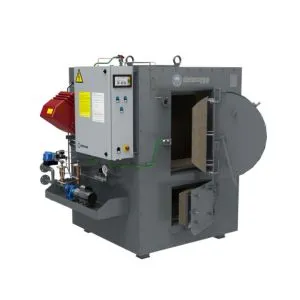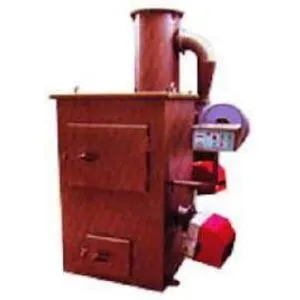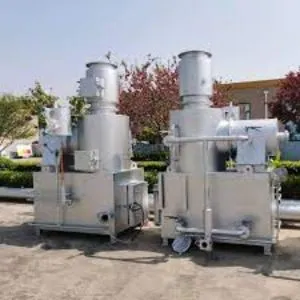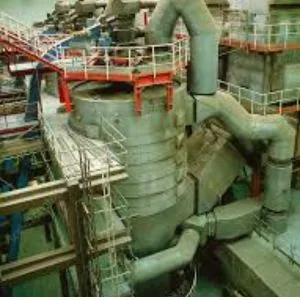Incinerators in UAE
(4 products available)An incinerator is a container or a facility which is designed for burning waste on a large scale. These pollution control devices & machines typically consist of a furnace where waste is loaded and ignited, often using a gas burner. The burning process continues in a secondary chamber at high temperatures, and flues direct gasses to a chimney. A modern incinerator has pollution control devices (like fabric filters and scrubbers) to remove ash and contaminants. Tall chimneys release cleaned gasses at heights for better dispersion, minimizing air pollution. Incinerator plants often have areas for temporarily storing and sorting waste. The incineration processes reduce community waste to about 10% of its original volume, aiding in efficient waste disposal.
An incinerator is a container or a facility which is designed for burning waste on a large scale. These pollution control devices & machines typically consist of a furnace where waste is loaded and ignited, often using a gas burner. The burning process continues in a secondary chamber at high temperatures, and flues direct gasses to a chimney. A modern incinerator has pollution control devices (like fabric filters and scrubbers) to remove ash and contaminants. Tall chimneys release cleaned gasses at heights for better dispersion, minimizing air pollution. Incinerator plants often have areas for temporarily storing and sorting waste. The incineration processes reduce community waste to about 10% of its original volume, aiding in efficient waste disposal.
An incinerator is a container or a facility which is designed for burning waste on a large scale. These pollution control devices & machines typically consist of a furnace where waste is loaded and ignited, often using a gas burner. The burning process continues in a secondary chamber at high temperatures, and flues direct gasses to a chimney. A modern incinerator has pollution control devices (like fabric filters and scrubbers) to remove ash and contaminants. Tall chimneys release cleaned gasses at heights for better dispersion, minimizing air pollution. Incinerator plants often have areas for temporarily storing and sorting waste. The incineration processes reduce community waste to about 10% of its original volume, aiding in efficient waste disposal.

- Fuel Type : Multi-Fuel
- Loading Method : Automatic
View more...
United Technical Services

- Capacity : 20-30 Kg/hr
- Temperature Inside : 800-10000C
View more...
Megamed Medical Equipment LLC
Other Categories

- Capacity : Variable
- Temperature : High
View more...
Facilities Management Middle East

- Capacity : Variable
- Fuel Type : Dual-Fuel
View more...
Huber Technology Middle East FZE
An easy way to post your sourcing requests and get quotes.
- One request, multiple quotes
- Verified suppliers matching
- Quotes comparison and sample request
Advantages of Incineration
- Waste Reduction: Incineration is likely to reduce the waste volume by around 90%, and remarkably minimizing the amount of waste sent to landfills and diminishing the necessity for additional landfill sites.
- Energy Generation: Additionally, incineration offers the opportunity to produce electricity, serving as a sustainable means of energy production. This helps reduce dependence on fossil fuels, promoting a more environmentally friendly energy source for homes and businesses.
- Job Creation: Operating and maintaining incineration plants requires skilled workers, thereby generating employment opportunities. This is particularly beneficial in areas facing high unemployment rates.
- Reduction of Greenhouse Gas Emissions: Incineration can effectively lower greenhouse gas emissions by up to 99%. By burning waste, it produces fewer methane emissions, a potent greenhouse gas, contributing to a cleaner environment.
- Space Reduction: Landfills are claiming valuable space that could be utilized for community development or industrial expansion. Incineration could potentially reclaim up to 95% of this space, returning it to regions for various purposes. While the soil may have been affected by the waste, rehabilitation is achievable through proper treatment and care.
- Controlling Pollutants: Unlike landfills, where methane and various air pollutants are generated, incineration facilities typically have controlled emissions. The primary concerns for incineration facilities are air and thermal pollution, whereas landfills can contaminate soil, water, and air with toxins and leachate, a liquid produced from landfill runoff.
Types Of Incinerators
Solid Waste Incinerators:
Incinerator waste are facilities designed to burn various types of waste, such as household trash, to reduce its volume and neutralize harmful components. Waste incinerators use high temperatures to combust waste, converting it into ash, gasses, and heat.
Industrial Waste Incinerators:
Industrial waste incinerators are used for burning industrial waste materials through the process of combustion. The primary goal of these containers handle a wide range of industrial by products and materials that require specialized treatment to minimize environmental impact.
Small Scale Incinerators:
These compact incineration units are suitable for lower volumes of waste, often used in rural or remote areas where larger facilities aren't feasible. Small scale incinerators are commonly used for disposing of medical waste, animal carcasses, or agricultural residues.
Smokeless Incinerators:
Designed to minimize or eliminate the emission of visible smoke during the combustion process. Smokeless incinerators employ advanced combustion technologies and filtration systems to ensure cleaner exhaust gasses.
Portable Incinerators:
Portable incinerators are compact facilities that can be easily transported and set up for on-site waste disposal. They are useful in emergency response situations, construction sites, or temporary facilities where traditional waste management options are limited.
Rotary Kiln Incinerators:
An incinerator that uses a rotating cylinder or kiln to burn waste materials efficiently. The rotation helps ensure thorough mixing and combustion of waste while also facilitating the removal of ash.
Municipal Waste Incinerator:
Large-scale facilities specifically designed to handle municipal solid waste generated by households and businesses within a city or region. Municipal waste incinerators play a crucial role in waste management strategies, reducing landfill usage and generating energy from waste.
VOC Incineration:
VOC stands for volatile organic compounds, which are harmful chemicals often found in industrial waste streams. VOC incineration involves burning these compounds at high temperatures to break them down into less harmful substances before releasing them into the atmosphere.
Medical Waste Incinerators:
Facilities specialized in disposing of medical waste, including hazardous materials like contaminated sharps, infectious waste, and pharmaceuticals. Medical waste incinerators adhere to strict regulations to ensure proper handling and destruction of potentially harmful materials.
Connect With Top-Notch Incinerators Manufacturers and Suppliers in UAE on TradersFind:
TradersFind is a trusted platform for finding Incinerators manufacturers and suppliers in UAE, simplifying the search for top-notch solutions. With a user-friendly interface, the website presents a comprehensive wide range of incinerator products such as incinerator energy plants, complete with detailed descriptions and specifications. The inclusion of verified company names, along with contact details including mobile and WhatsApp numbers. TradersFind not only streamlines the shopping process but also ensures that users can confidently connect with reputable suppliers. Whether for waste management or environmental needs, TradersFind stands as a valuable resource, making the process of finding and acquiring incinerators in the UAE hassle-free and efficient.

















